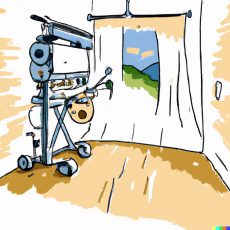AI generated art is in full swing and the Indian Copyright Office is confused. AI generated art is created autonomously by artificial intelligence without creative contribution from humans (see below the image Dall-E 2 created with my prompt “a machine painting a canvas”). Such works qualify as ‘computer generated works’ under the Indian Copyright Act. Computer-generated works were included as a category of works in 1995, presumably at a time when AI was not making art. For such works, copyright law confers authorship to the “person who causes the work to be created”. The question of whether AI can be named as an author of a work is debatable. There is no Indian precedent to suggest that authorship can be conferred to computer / software. There is also no policy guidance from the Indian Copyright Office on whether only humans can be considered authors.

The Indian Copyright Office is also unsure how to deal with such applications. As reported, in 2020, the copyright office rejected an application which listed AI (RAGHAV) as the sole author for an artwork. However, a second application was filed where a natural person and an AI (again (RAGHAV) were named as co-authors for another artwork. This copyright office granted registration in this case. The basis of grant of registration is not clear. It appears that the Copyright Office granted this registration by mistake, without applying its mind, as it issued a withdrawal notice, around one year later. In the withdrawal notice, the Copyright Office shifts the burden on the applicant to ‘inform the Copyright Office about the legal status of the AI tool Raghav Artificial Intelligence Painting App’.
The (human, co-author) applicant is now arguing that a copyright registration cannot simply be ‘withdrawn’ once it has been granted. The procedure is a rectification proceeding, to cancel the registration, before court. As reported, this notice was issued around November 2021. The current status of this proceeding is unclear. But as per the website of the Copyright Office, the status of this application is still ‘registered’.
Admittedly, this is old news. However, given that AI generated artwork has not died out and has instead picked up momentum, this issue is still worth considering.
Until this application is actually struck off the register (or corrected, if such corrections are permissible), it may operate as precedent for subsequent applications. While the Copyright Office may now believe that copyright protection is conditioned on human authorship, its hands are tied. If subsequent applications are denied, applicants may approach courts citing wrongful rejection. Either way, it looks like the Copyright Office may need to spend time, money and resources fighting this issue before court. This could have been avoided if the office had not flip-flopped in its decision in the first instance.
It is surprising to see copyright registrations being handed out without thought. This is especially concerning given that High Courts are now elevating the status of copyright registrations from mere registrations (results of non-mandatory, administrative processes) to bullet-proof licenses. As Lokesh explains, the Gujarat High Court recently held that certificates of registration from the Copyright Office provide immunity from copyright infringement. As he explains, this interpretation is incorrect.
On one hand, there is a lack of legal precedent as to whether or not AI can be classified as an author. A Parliamentary Standing Committee has recommended ‘revisiting of IPR legislations and implementing a strong IPR framework’ in order to ‘extract benefits from AI’. However, the law itself remains unchanged and unclear. On the other hand, it may be procedurally possible to secure copyright registration naming AI as a co-author and also use the registration as a shield against claims of copyright infringement. A worrisome paradox.
New technology is puzzling and countries world over are grappling with the same issue. For instance, the US Copyright Office has categorically rejected such applications on the grounds that a ‘work meets legal and formal requirements of copyright protection only if it is created by a human author’. The UK Intellectual Property Office, on the other hand, understands the evolving nature of computer generated works and is taking a wait and watch approach.
Indian authorities should probably plan out their approach to tackle such issues rather than take hasty action and create precedents that can turn out to be dangerous in the future.

Pingback: Dali v. Dall-E: The Emerging Trend of AI-generated Art - Tech Law Forum @ NALSAR
Pingback: Chronicles of AI: Blurred Lines of Legality and Artists' Right To Sue in Prospect of AI Copyright Infringement - Tech Law Forum @ NALSAR